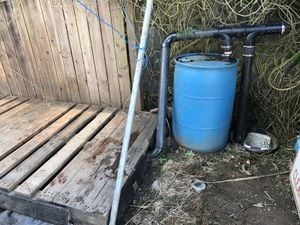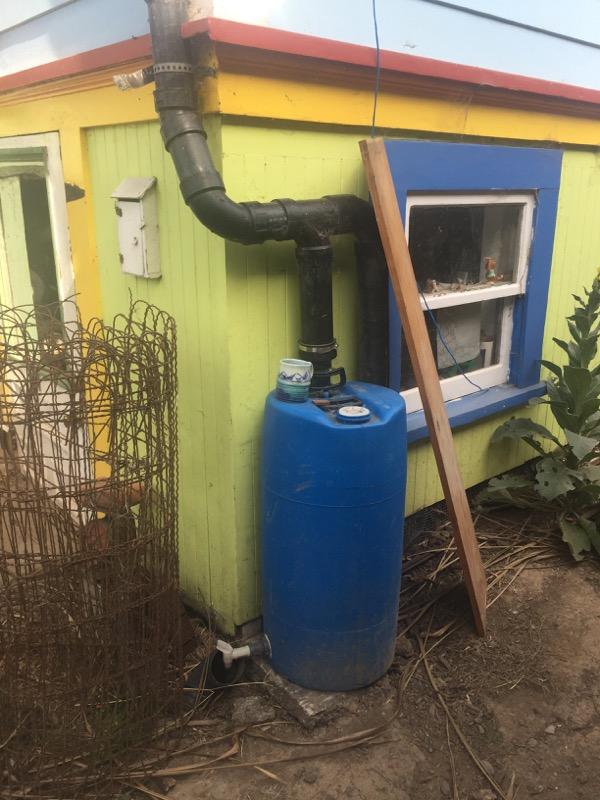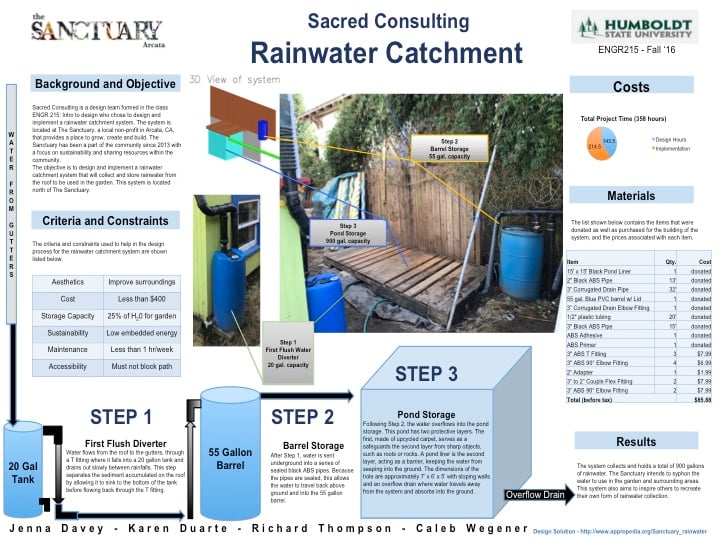No edit summary |
mNo edit summary |
||
| Line 213: | Line 213: | ||
[[Category:Rainwater]] | [[Category:Rainwater]] | ||
[[Category:Projects]] | [[Category:Projects]] | ||
==Update October 2017== | |||
Interviewed Natalie about how the the catchment system is doing. | |||
Overall health of the system is great, everything from the first flush to the storage. | |||
Currently using the water for watering plants in the garden. | |||
The system is doing great and satisfying their current needs; a future system is not currently on their radar. | |||
[[File:The Black Hole Storage 1.jpg]] | |||
Picture of the Black hole in October 2017. | |||
Revision as of 04:16, 16 October 2017

Abstract
A rainwater catchment system was designed and constructed at The Sanctuary in Arcata, CA. This project was completed for Humboldt State University class, ENGR 215 FALL 16, and is a collaboration between four students. The catchment system can hold up to 900 gallons of captured rainwater. A 55 gallon drum is used as the secondary storage. A 850 gallon pond acts as the primary storage for the system. The pond is covered with a bridge, for walking or storage, and the pond contains an overflow drain.
Background
Sacred Consulting is a team of four students in the Fall 2016 semester of ENGR 215 at Humboldt State University consists of: Jenna Davey, Karen Duarte, Richard Thompson, and Caleb Wegner. This group chose to design and construct a rainwater catchment system for the client. The client for this project is The Creative Sanctuary, a local non-profit art facility who promotes green technology, art, community involvement and sustainable living. Even though this client has one rainwater catchment system on the property already, there are 2 gutters currently not being used for collection.
Problem statement and criteria
Criteria and constraints are a set of useful guidelines to refer to when deciding which design best fits the needs of the client.
Problem Statement
The Creative Sanctuary has two rain gutters that are not being used to collect the water, and would like to use one or both of them as inputs to a rainwater catchment system.
Criteria
Below is a table that displays the criteria laid out to assist in the decision making process.
| Criteria | Importance | Constraints |
|---|---|---|
| Sustainability | 9 | Obtain the lowest embedded energy for each item in the system. |
| Cost | 8 | Spend less than $400. |
| Usefulness | 8 | Storage capacity must provide at least 25% of the water for the garden and other outdoor uses. |
| Maintenance | 8 | Maintenance must require less than 1hr per week. |
| Aesthetics | 7 | look as good or better than the surrounding structures. |
| Accessibility | 5 | The area must still be available to foot traffic. |
| Sizing | 4 | Water storage must match the volume of the water coming into the system. |
Description of final project
Photos and descriptions.
- The Black Hole gallery
-
Before photo.
-
Before photo of the existing gutter.
-
Digging the "Black Hole."
-
"The Black Hole" takes form.
-
Putting used carpet in the "Black Hole."
-
Foundation for the secondary storage.
-
First flush water diverter.
-
Secondary storage and plumbing heading into "The Black Hole."
-
"The Black Hole" secondary storage.
-
Quick disconnect for the secondary storage tank.
-
"The Black Hole" is done.
Cost Table
The costs in hours for this project are listed below. The total hours spent by the team both designing and implementing the system is 150 hrs.
The monetary costs of this project are minimal considering the amount of donated materials which came from the client, The Sanctuary. The total cost of the system is $83.88 and a breakdown of the cost of each item can be seen below.
| Quantity | Material | Source | Cost ($) | Total ($) |
|---|---|---|---|---|
| 1 | 15' x 15' Black Pond Liner | Donated | 0.00 | 0.00 |
| 13 ft. | 2" Black ABS Pipe | Donated | 0.00 | 0.00 |
| 32 ft. | 3" Black Corrugated Drain Pipe | Donated | 0.00 | 0.00 |
| 1 | 55 gallon Blue PVC barrel w/ White Lid | Donated | 0.00 | 0.00 |
| 1 | 3" Black Corrugated Drain Elbow Fitting | Donated | 0.00 | 0.00 |
| 1 | 1/2 Plastic Tubing | Donated | 0.00 | 0.00 |
| 179" | 3" Black ABS Pipe | Donated | 0.00 | 0.00 |
| ABS Adhesive | Donated | 0.00 | 0.00 | |
| ABS Primer | Donated | 0.00 | 0.00 | |
| 3 | 3" ABS Tee Fitting | Ace Hardware | 7.99 | 23.97 |
| 6 | 3" ABS 90 (degrees) Elbow Fitting | Ace Hardware | 6.99 | 41.94 |
| 1 | 2" Adapter | Ace Hardware | 1.99 | 1.99 |
| 2 | 3" to 2" Couple flex Fitting | Ace Hardware | 7.99 | 15.98 |
| Total Cost | $83.88 | |||
Testing Results
The system is currently filling up and storing water, but has not had the chance to provide water to the garden because the rain has been sufficient enough up to this point in time.
How to build
In order to replicate the rainwater catchment system that was built for the Sanctuary, follow the steps below. YOU WILL NEED A SHOVEL.
Maintenance
"The Black Hole" was designed to need as little regular maintenance as possible. Due to this there is only an estimated 7 hours per year in required maintenance. The breakdown of what tasks need to be done and the estimated cost are shown below.
Schedule
Every year the system needs a complete cleaning and winterization. This annual cleaning should be performed in the fall of the year before the rains start. This allows the system to be as clean as possible before filling with water. If the entire system needs to be cleaned and the pond is full of water, that water must be emptied so that the pond liner can be removed to be cleaned. While the total cleaning time can vary, cleaning the pond liner should only take one hour if all the water has been removed.
The other task that will need to be completed is the emptying and cleaning of the first flush water diverter and the secondary tank. Occasionally, this first flush diverter will become clogged with debris and sediment. Time needed to empty and clean the first flush water diverter and secondary storage is estimated to take less than one half of an hour. This maintenance is recommended to be performed once a month.
In total the system should require under 7 hours of maintenance per year.
- Monthly
- Empty and clean secondary storage
- Empty and clean first flush diverter
- Yearly
- Remove/Clean/Replace pond liner
- Flush all pipes and clean gutters
Troubleshooting
This is only how to troubleshoot basic operation. For complex issues, contact Lonny Grafman (HSU).
| Problem | Suggestion |
|---|---|
| Water is not flowing into the pond. | Check flow by putting a hose into the gutter and find clogged area. |
| Water is dirty. | First flush diverter is not draining properly. |
| Pond wall integrity | Too much water in area surrounding the pond. |
Discussion and next steps
References
See Help:Footnotes for more. Template:Reflist
Poster
Update October 2017
Interviewed Natalie about how the the catchment system is doing.
Overall health of the system is great, everything from the first flush to the storage.
Currently using the water for watering plants in the garden.
The system is doing great and satisfying their current needs; a future system is not currently on their radar.
 Picture of the Black hole in October 2017.
Picture of the Black hole in October 2017.











